You never know when creativity will strike. Three years ago I was cleaning out my desk when I stumbled upon a ziplock bag of index cards from a game I had introduced to my friends called “1000 Blank Cards.” The idea with the game was that you would supply all the players with a pen and a stack of index cards to play a turn-based game where the rules of the game were established each turn by the players.
I had played this game with different groups of people and to varying results; but often, the cards would be tossed in the garbage at the end of the night. I had kept this stack for some reason—perhaps destiny. As I shuffled through the cards, I noticed one called “Pinocchio, Vampire Slayer.” I chuckled, and then was struck by an idea: what if I designed a Magic set around fairy tales?
Jump forward to today, and I have designed a set—in what little free time I have—that is pretty close to being finished. Over the next two weeks, I will walk through my process and what I’ve learned. The cards themselves are not really the point, though I would advise any Wizards of the Coast employees to turn back now, as I understand there are limits to what you can legally look at.
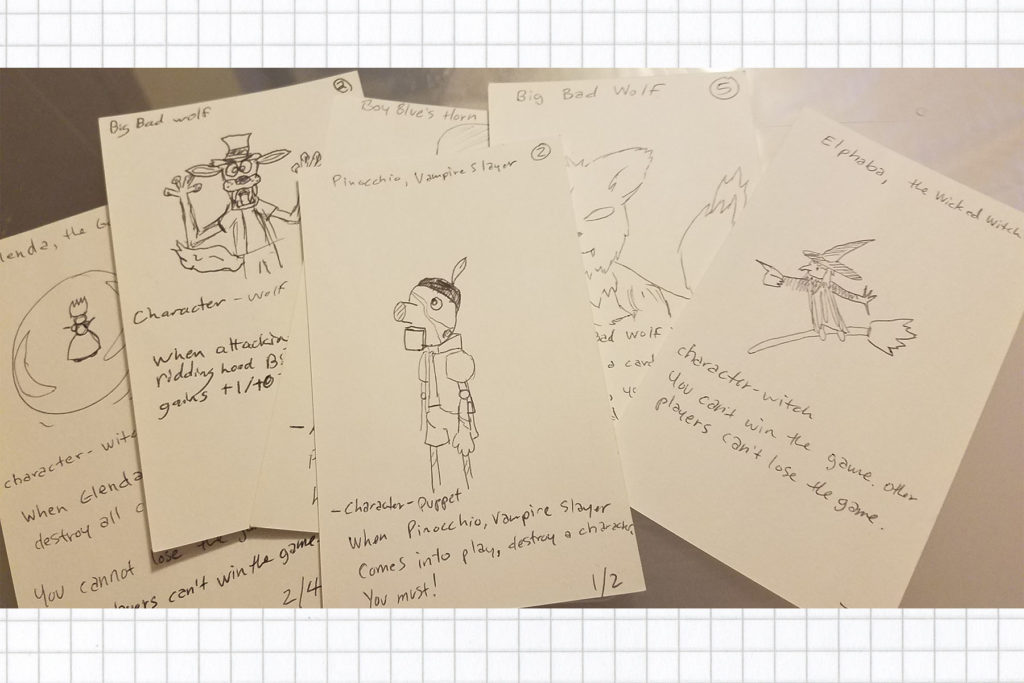
As a fairy tale set, I wanted to get some of my insights out before we dive into the Fall set, Throne of Eldraine. I will be highlighting some of the trials I went through as I set goals and saw results. It’s been a long, strange journey.
Designing around Mythic Fiction
From the get-go, I had the intention of designing my set around “mythic fiction“—literature that is rooted in, inspired by, or draws from the tropes, themes, and symbolism of myth, legend, folklore, and fairy tales. I became aware of mythic fiction through the comic book series, Fables, which played around with these tropes by presenting the characters we knew in a modern New York environment. This made for a fairly easy first few steps in the design process, as I made lists of characters I would like to transplant into a Magic set and started making cards out of them.
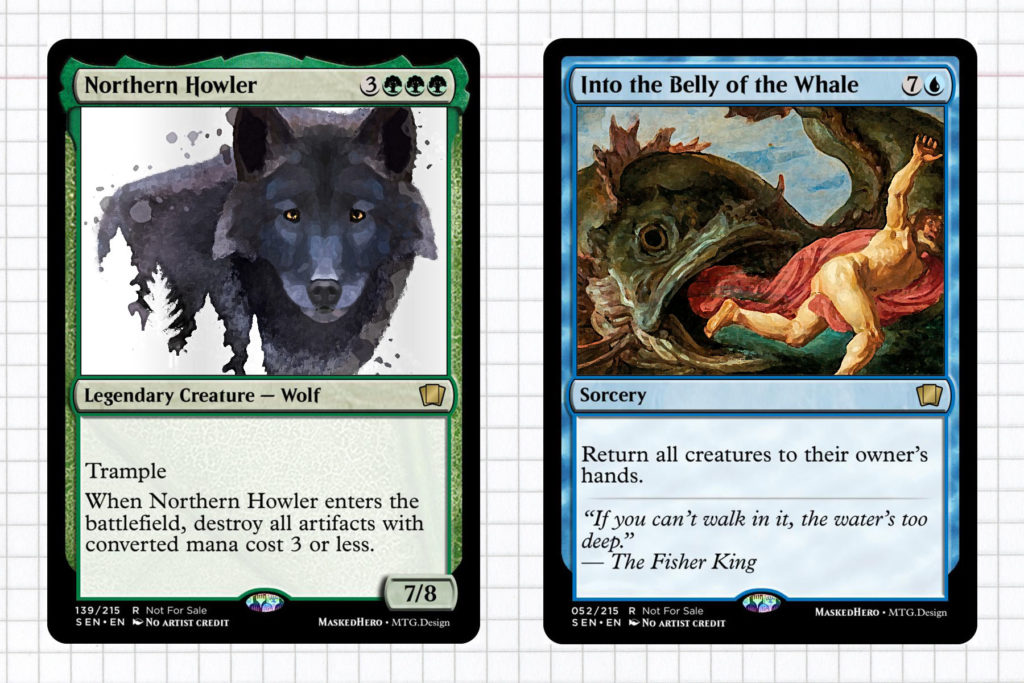
Very quickly, I had a Big Bad Wolf, the three little pigs, and a whale big enough to swallow whole ships all designed into different cards. I was pouring through copies of Aesop’s Fables looking for archetypal stories that could translate to cardboard, while looking for the mechanical space upon which to hinge the set. This was a good start, but at some point I had discovered that my net may have been cast too wide.
The longer I designed, the more certain tribes and archetypes stood out to me. At this point, I wanted to push scarecrow and wolves as tribes, mainly coming from my own preconceived importance of The Big Bad Wolf and the novel concept of giving my Pinocchio figure the scarecrow type. This informed my mechanics, themes, and eventually the lore my world was built upon. Before I knew it, I had carved out a narrower design space, landing in a world that was The Wizard of Oz meets Pinocchio. Soon that world had a name: Sencora.
The Lore of Sencora
Ideas are an interesting beast that can develop from the smallest of acorns. The lore of what would become Age of Sencora dated back to that night of “1000 Blank Cards” when I mimicked Platinum Angel and Abyssal Persecutor under the flavor of The Good Witch and The Wicked Witch of the West. The designs were meant to be funny that night, but the inspiration stuck with me and drove me to create monuments that honored good witch, Glinda and bad witch, Mombi while using the text “You can’t lose the game” and “You can’t win the game” respectively.
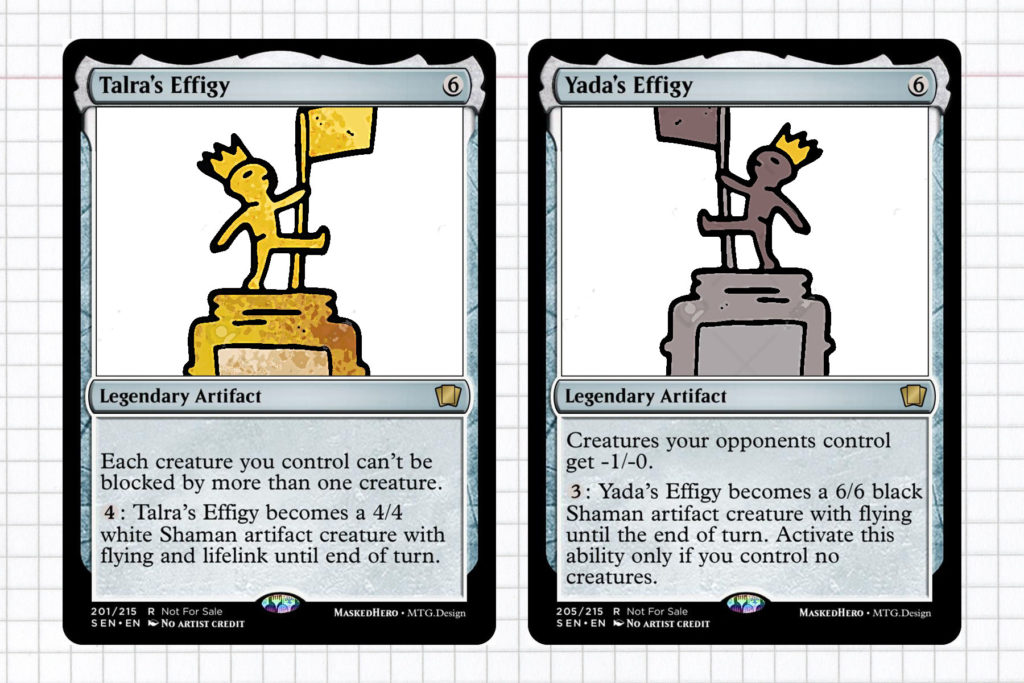
While I was content with these designs as fun mirrors of each other, both set balance and a nagging feeling kept eating away at me. What were these monuments really for? I began to reverse engineer the answer. I figured that the legendary creature tentatively known as Glinda would inspire the Munchkins, who became Kithkins, as Magic had already supplied us with that analog. But for the Mombi counterpart, I didn’t feel flying monkeys were really appropriate and chose to have her be an inspiration for the faeries of Sencora. Suddenly I had two witches, their followers, and the implication that they were dead. But what happened to them? If one of them had slain the other, the victor would still be kicking around.
With no urgency to cement the lore, I went off and started filling out other areas of the world. I began to develop this world’s version of Gepetto and his army of scarecrows. I tried to design a card around the story of The Fisher King. Then it hit me while grocery shopping. In the Oz books, The Wicked Witch of the West is not the big bad. The Nome King is.
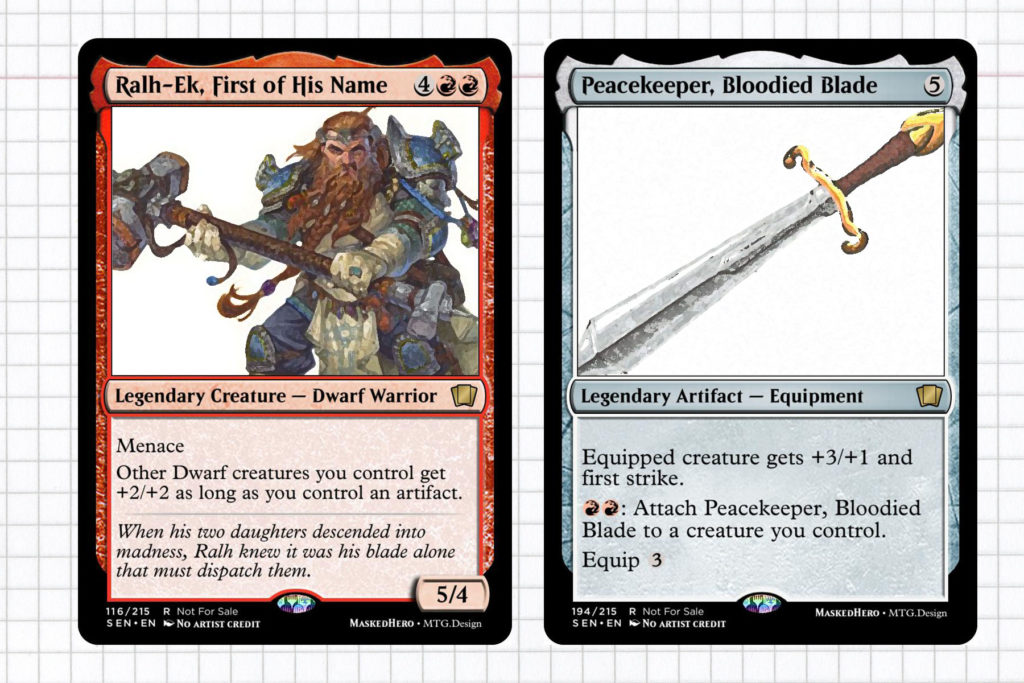
My version of the character became Ralh-Ek of the under-mountain nation of Ek. He had slain the two warring witches. Because the characters—now known as Yada and Talra—are sisters, he is their dwarven father, who mercy-killed them with this legendary weapon, Peacekeeper. And in a flash, the world took on a whole new dimension. I was designing a fairy-tale world where a world-shaking event had happened in the recent past, but wasn’t the only thing populace worried about as they tucked their children in at night.
The Mechanics of Sencora
Because so much of my focus was drifting towards the Wizard of Oz novels, this is where I feel my design likely diverts from what Wizards is likely to do in Throne of Eldraine for obvious reasons. While I fully expect that we will see analogs like The Big Bad Wolf and The Billy Goats Gruff, with the world-altering event of the two sisters looming over the world; I began to create an entire civilization that were living in fear not only from the threat of more witches, but the sinister threat of the Gallybagger Sovereign (Gepetto) and his army of scarecrows. This created room for a mechanic, Conform, which asked the player to focus their deck into permanents that shared colors, communicating that trust was built not through tribal themes, but through color alignment.
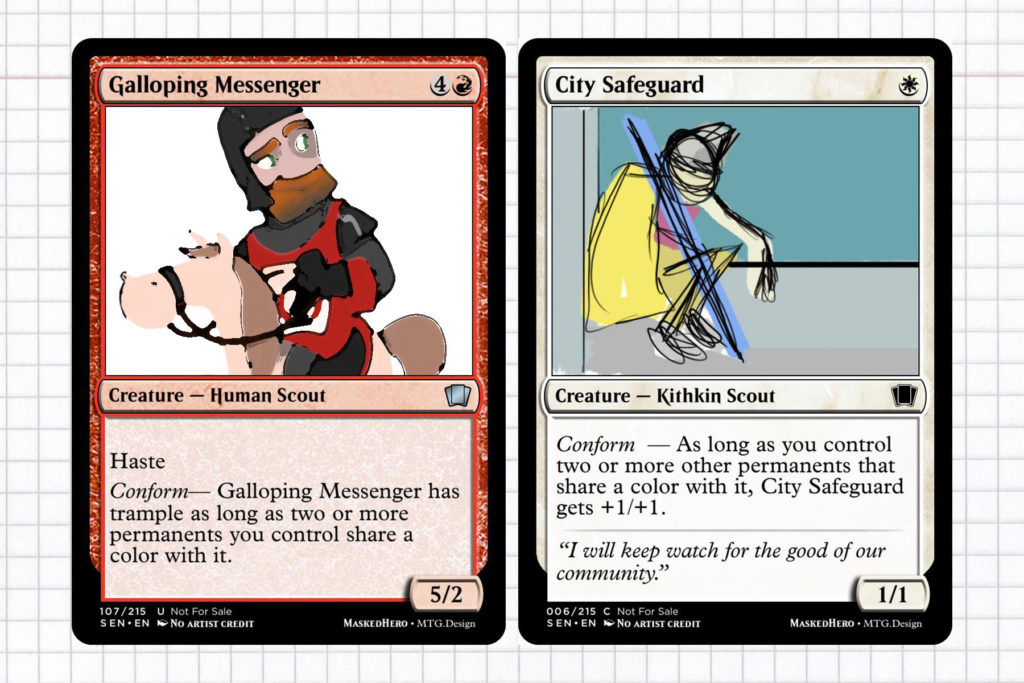
Where as Conform fell into place and found its sweet spot pretty quickly over the course of the set, the mechanic that would become Dilemma went through half a dozen iterations to finally settle into its place as my card advantage mechanic.
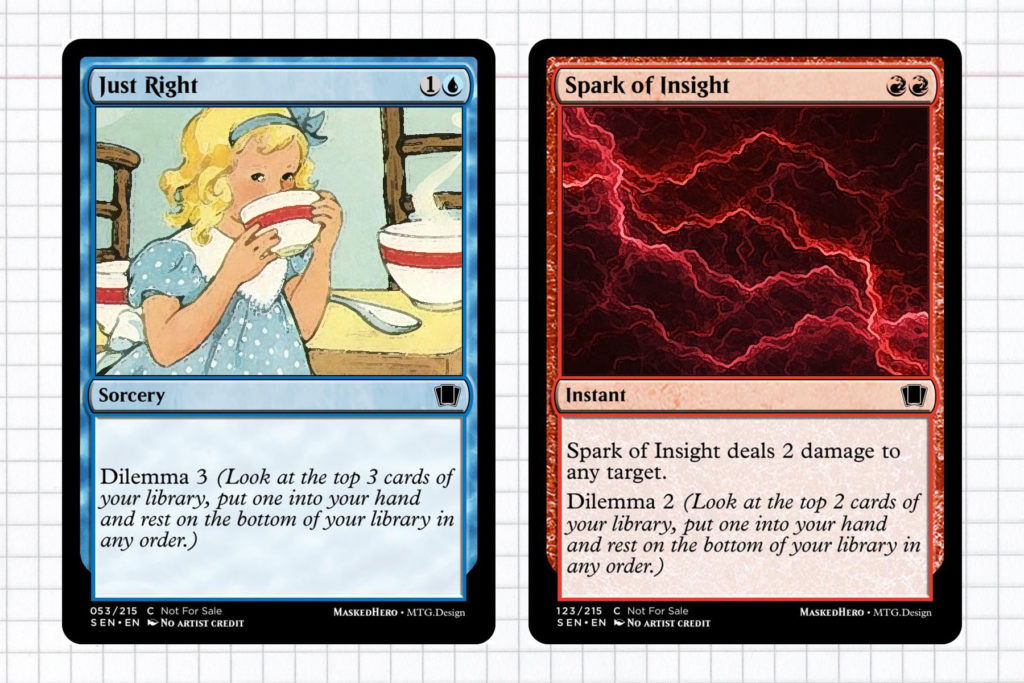
The idea seemed simple enough. I wanted a mechanic that would help players work through their deck similar to how cycling was used during Shards of Alara. The flavor goes a little meta, trying to capture the parable sense of many fairy tales. It offers choices that the character—and now the player—must make, with the threat of losing the other option. As Adam Victor Klesh of the Beacon of Creation podcast pointed out, Dilemma two is Sleight of Hand, three is Anticipate, and four is Impulse. This brought untold joy to me, as I felt that I had discovered a mechanic Wizards had always had, but never named.
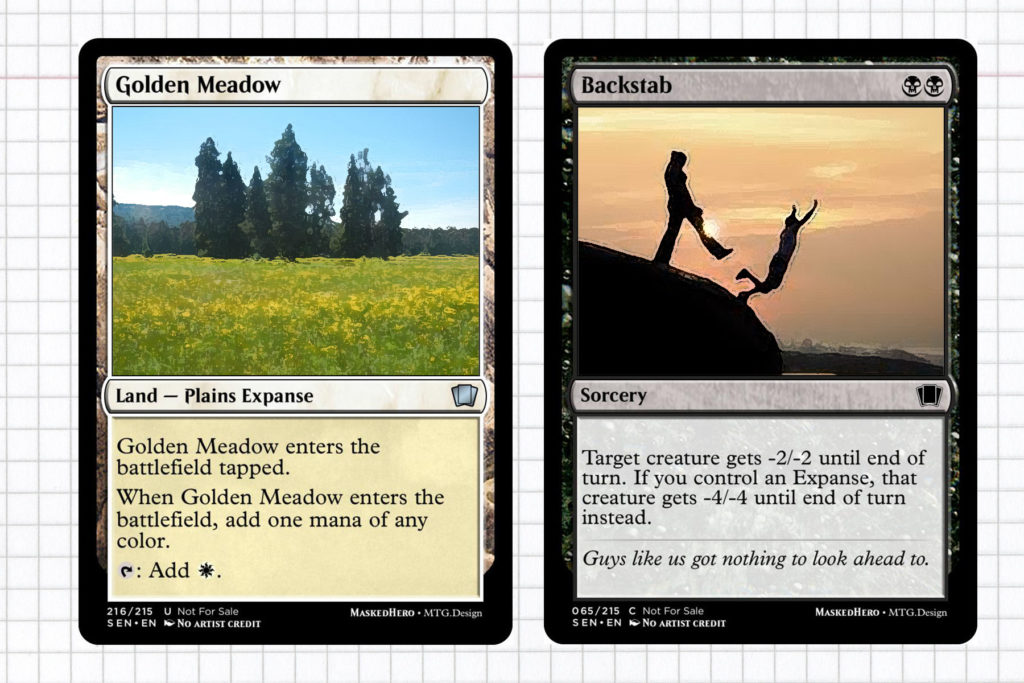
The last piece of the mechanical identity of Age of Sencora was Expanses. The issue I ran into here was that I had been working on a mechanic that in one version could have just been a renamed Flashback and in other version was an overly complicated split card that used the Exiled Zone. This resulted in a set where one mechanic cared about the board (Conform), another cared about the library (Dilemma), and the last was exiling cards. Sometimes I would read through the card file and feel pulled in too many directions.
So I took a step back and looked at how the mechanics I liked interacted with the set and realized that I need something simpler that either played up the meta storytelling aspect of the set or helped to paint a picture of the world. Once again inspired by Oz, I ultimately chose to create a new land type that was meant to illustrate the beautiful parts of the world that would inspire a bit of wanderlust.
With that I’ve reached the end of my time this week. I think getting some of the dense background details about how the set found a lot of its identity is crucial to understanding next week’s topics, as I get into a lot more of the lessons I learned crafting this custom set. Next week I will be covering some of the insights I have gleaned from playtesting, going public with my designs, and killing some of my darlings. No part of this set is perfect, but I hope by sharing some of my novice thoughts, it will help to empower others to take a few risks and design their own sets.
Ryan Sainio is a Graphic Designer who writes about EDH and the EDH community. He has been playing Magic: The Gathering since 7th Edition in 2002 and values flavorful and fun gameplay over competitively optimized decks.

